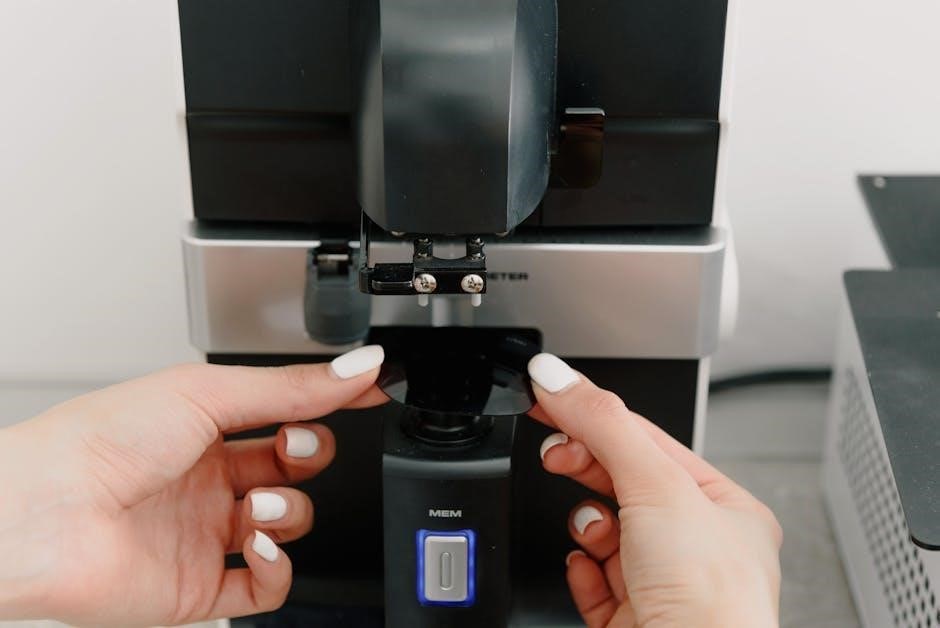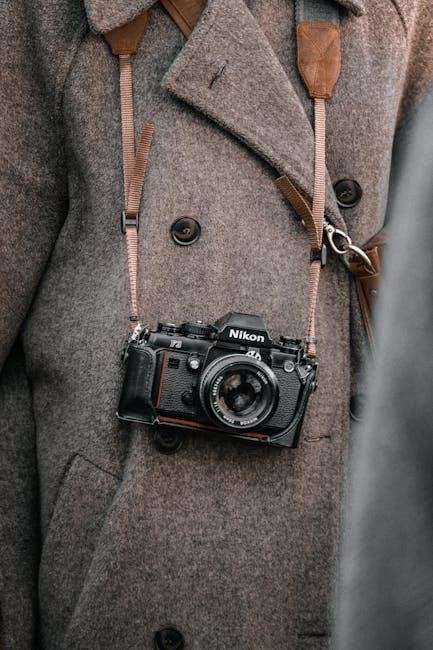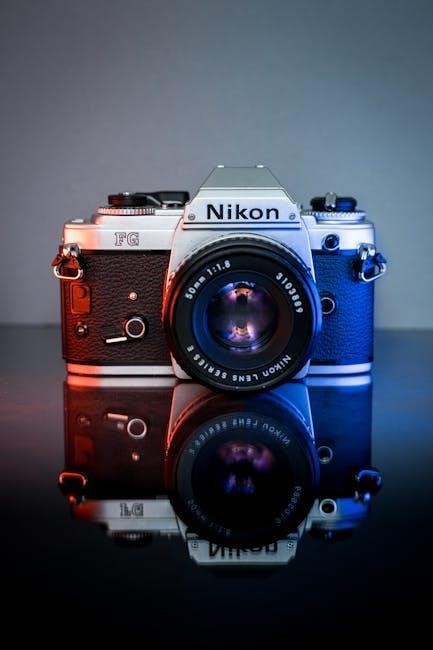The Nikon D50 Owner’s Manual is your comprehensive guide to mastering the camera’s features. This section introduces you to the camera’s components, shooting modes, and custom settings, ensuring you get the most out of your photography experience.
Overview of the Nikon D50
The Nikon D50 is a lightweight, compact DSLR camera designed for both amateur and enthusiast photographers. It features a 6.1-megapixel DX-format CCD sensor, delivering vivid images with sharp details. The camera offers a 5-area autofocus system for precise subject capture and supports an ISO range of 200-1600, making it versatile for various lighting conditions. With compatibility for SD memory cards and multiple shooting modes, the D50 provides creative control and flexibility for capturing high-quality photos.
Importance of Reading the Manual
Reading the Nikon D50 Owner’s Manual is essential for understanding the camera’s features, functions, and settings. It provides detailed guidance on optimizing image quality, troubleshooting common issues, and utilizing advanced modes. The manual also helps users familiarize themselves with the camera’s components and custom settings, ensuring they make the most of their photography experience. Referencing the manual regularly can enhance your skills and help you capture stunning photos effortlessly.

Key Features of the Nikon D50
The Nikon D50 boasts a 6.1 MP DX-format CCD sensor, 5-area autofocus, and an ISO range of 200-1600. It supports RAW image format and offers versatile shooting modes for enhanced creativity and control.
6.1 Megapixel DX Format CCD Sensor
The Nikon D50 features a 6.1 megapixel DX-format CCD sensor, designed to capture high-quality images with excellent detail and color accuracy. This sensor is ideal for both amateur and professional photographers, delivering vibrant colors and sharp details. Its compact size and efficient design make it perfect for everyday photography, ensuring outstanding results in various lighting conditions.
5-Area Autofocus System
The Nikon D50’s 5-Area Autofocus System delivers precise and fast subject acquisition, ensuring sharp images even in challenging lighting conditions. This advanced system automatically selects the best focus point or allows manual selection, providing greater control over your photography. It excels at capturing moving subjects, making it ideal for action and portrait photography while maintaining user-friendly operation for photographers of all skill levels.
ISO Sensitivity Range (200-1600)
The Nikon D50 features an ISO sensitivity range of 200 to 1600, providing flexibility in various lighting conditions. This range allows for sharp images in low-light environments while minimizing noise; The camera performs exceptionally well at higher ISO settings, delivering clear results with minimal grain. This makes it ideal for capturing high-quality photos in both bright and challenging lighting situations, offering photographers versatility and reliability. Adjust ISO settings easily using the dedicated button and command dial for optimal results.
Support for RAW Image Format
The Nikon D50 supports the RAW image format, capturing photos in uncompressed, high-quality files. This feature offers greater flexibility in post-processing, allowing adjustments to exposure, white balance, and sharpness without losing image data. RAW files provide better image quality than JPG, ideal for professional photographers. The D50’s support for RAW, alongside JPG and NEF, ensures photographers can choose the best format for their needs, enhancing their creative control and output thus.
Understanding the Camera Components
The Nikon D50 features essential components like external controls, viewfinder, and LCD screen for easy navigation. Memory card slots and buttons ensure intuitive operation, helping users capture stunning images effortlessly.
External Controls and Buttons
The Nikon D50 features a range of external controls designed for intuitive operation. The Mode dial on the top left allows selection of shooting modes, while the ISO button near the LCD screen adjusts sensitivity. The shutter release button is centrally located for easy access, and the command dial enables quick adjustments to settings like aperture and shutter speed. These buttons and controls provide quick access to essential functions, enhancing your shooting experience.
Viewfinder and LCD Screen
The Nikon D50 features a pentamirror-type viewfinder with 0.95x magnification, providing a clear and accurate preview of your scene. The 2-inch TFT LCD screen displays images and settings with 130,000-dot resolution. The LCD offers brightness adjustment and supports image playback, shooting settings, and histograms. Together, the viewfinder and LCD screen ensure precise composition and convenient review of your photos, enhancing your overall photography workflow.
Memory Card Slots
The Nikon D50 is equipped with a single memory card slot that supports SD and SDHC memory cards. For optimal performance, use cards with a capacity of up to 8GB. Always format your memory cards in the camera to ensure compatibility and prevent data loss. Regularly cleaning the card slot and using high-quality cards will help maintain reliable storage and transfer of your images. This ensures your photography sessions run smoothly and efficiently.
Shooting Modes
The Nikon D50 offers multiple shooting modes, including Auto, Program, Aperture Priority, Shutter Priority, and Manual. These modes provide flexibility for various photography needs, from automatic simplicity to full creative control.
Auto Mode
Auto Mode simplifies photography by automatically adjusting settings like aperture, shutter speed, and ISO (200-1600) for optimal results. It’s ideal for beginners or quick shots, delivering vibrant colors and sharp images. The camera handles focus, exposure, and white balance, allowing you to point and shoot effortlessly. For better low-light photos, the built-in flash activates automatically. This mode ensures great results with minimal effort, making it perfect for everyday photography and learning the basics of your Nikon D50.
Program Mode
Program Mode offers a balance between automation and control, letting the camera handle exposure while allowing adjustments to settings like aperture, shutter speed, and ISO (200-1600). It’s ideal for photographers who want flexibility without manual mode complexity. The camera automatically selects optimal settings, but users can tweak them for creative results. This mode is perfect for various lighting conditions and provides a great learning tool for understanding exposure dynamics on the Nikon D50.
Aperture Priority Mode
Aperture Priority Mode allows you to set the aperture while the camera automatically adjusts the shutter speed for proper exposure. This mode is ideal for controlling depth of field—use a wide aperture (low f-stop) for a shallow focus effect or a narrow aperture (high f-stop) for greater sharpness across the image. It’s perfect for creative photography, enabling you to prioritize your desired visual outcomes with precise aperture control on the Nikon D50.
Shutter Priority Mode
Shutter Priority Mode lets you set the shutter speed, and the camera adjusts the aperture for proper exposure. This mode is perfect for capturing fast-moving subjects or creating motion blur. Ideal for sports and low-light photography, it offers precise control over the shutter speed, allowing you to achieve the desired visual effects with ease on your Nikon D50.
Manual Mode
Manual Mode gives photographers full control over both aperture and shutter speed, allowing for precise adjustments to achieve desired effects. Ideal for experienced users, this mode is perfect for challenging lighting conditions or creative expression. Adjust settings in small increments and use the built-in light meter for guidance. It offers unparalleled flexibility for portraits, landscapes, or action photography, making it a favorite among professionals and enthusiasts alike on the Nikon D50.
Custom Settings
Custom Settings on the Nikon D50 allow you to personalize camera functions, such as autofocus, metering modes, and flash settings, for precise control over your photography experience.
Autofocus Settings
The Nikon D50 features a 5-area autofocus system for precise subject tracking. You can choose between Single AF, Continuous AF, and Manual Focus modes. Use the AF Lock button to freeze focus on your subject; Customizing AF settings enhances sharpness and ensures your images stay in focus, even with moving subjects. This feature is particularly useful for action and portrait photography, allowing you to tailor autofocus behavior to your shooting style.
Metering Modes
The Nikon D50 offers three metering modes: Matrix Metering, Center-Weighted Metering, and Spot Metering. Matrix Metering analyzes the entire scene for balanced exposure. Center-Weighted Metering prioritizes the center of the frame, ideal for portraits. Spot Metering measures light from a small area, perfect for challenging lighting conditions. These modes allow you to customize exposure settings, ensuring accurate results in various shooting scenarios. Proper use of metering modes enhances image quality and control over lighting.
Flash Settings
The Nikon D50 offers versatile flash settings to enhance your photography. The built-in flash can be set to Auto, Red-eye reduction, or Slow synchronization modes. Auto mode automatically activates the flash in low-light conditions. Red-eye reduction minimizes red-eye effects in portraits. Slow sync balances flash with ambient light for creative results. These settings, accessed via the flash button and command dial, provide flexibility for various lighting scenarios, ensuring well-lit and natural-looking images. Proper use of flash modes can elevate your photography to the next level.
Image Quality and Settings
The Nikon D50 delivers high-quality images with its 6.1-megapixel sensor. It supports JPG, NEF, and RAW formats, offering flexibility for post-processing and ensuring detailed, vibrant photos.
Still Image Resolution Options
The Nikon D50 offers multiple still image resolution options to suit your needs. Choose from 3008×2000, 2256×1496, or 1504×1000 pixels. These options provide flexibility, allowing you to balance file size and image quality. Higher resolutions are ideal for detailed prints, while lower resolutions are perfect for web use or storage efficiency. This feature ensures you can tailor your images to your specific photography goals.
File Formats (JPG, NEF, RAW)
The Nikon D50 supports three file formats: JPG, NEF, and RAW. JPG is ideal for sharing and printing, offering compressed files with minimal storage needs. NEF (Nikon Electronic Format) and RAW capture uncompressed data, preserving maximum image detail for advanced post-processing. These formats provide flexibility, whether you prioritize convenience or professional-grade image quality, making the D50 versatile for both casual and enthusiast photographers.

Memory and Storage
The Nikon D50 supports compact flash cards for storing images. Proper memory card formatting ensures optimal performance and prevents data corruption, while using high-quality cards guarantees reliable storage for your photos.
Compatible Memory Cards
The Nikon D50 is compatible with CompactFlash (CF) cards, including Type I and Type II, with capacities up to 4GB. For optimal performance, use high-speed CF cards to ensure fast data transfer and reliable storage. Always format memory cards in the camera to maintain compatibility and prevent data corruption. Using high-quality cards is essential for storing your photos securely and efficiently.
Formatting Memory Cards
Formatting memory cards ensures compatibility with your Nikon D50 and prevents data corruption. To format, access the camera’s menu, navigate to the setup or memory card section, and select Format. Note that formatting erases all data on the card, so back up your photos first. Always format cards in the camera rather than on a computer for optimal performance and to maintain proper camera functionality.
Battery and Power Management
The Nikon D50 uses the EN-EL9 rechargeable lithium-ion battery. Charge it with the included MH-23 charger. Enable power-saving features to extend battery life, such as turning off the LCD when not in use.
Battery Types and Charging
The Nikon D50 is powered by the EN-EL9 rechargeable lithium-ion battery. To charge, use the MH-23 battery charger provided. Plug the charger into a power outlet, insert the battery, and wait for the LED indicator to turn green, signaling a full charge. Charging typically takes about 2 hours. Always charge the battery before first use and avoid overcharging to maintain battery health. The camera does not support USB charging.
Power Saving Features
The Nikon D50 incorporates several power-saving features to extend battery life. The camera automatically turns off after a period of inactivity, which can be set to 4, 8, or 16 minutes. Additionally, the LCD monitor’s brightness can be adjusted to consume less power. These features help ensure efficient energy use, allowing for more shots on a single charge. Regularly updating firmware may also improve power management efficiency.

Maintenance and Cleaning
Regularly clean the Nikon D50 with a soft cloth to prevent dust. Avoid harsh chemicals. Refer to the manual for sensor and lens cleaning to maintain performance.
Cleaning the Sensor
Cleaning the sensor is crucial for maintaining image quality. Use a soft, dry cloth to gently remove dust. Avoid harsh chemicals or excessive moisture. For stubborn particles, refer to the manual for recommended cleaning tools and techniques. Always power off the camera before cleaning to prevent damage. Regular maintenance ensures optimal performance and prevents scratches or damage to the sensor.
Caring for the Lens
Regular lens care is essential for maintaining clarity and performance. Use a soft, dry cloth to wipe away smudges or fingerprints. Avoid harsh chemicals, as they may damage the lens coating. For stubborn marks, use a lens cleaning solution with a microfiber cloth. Store the lens in a protective case when not in use to prevent scratches. Always handle lenses with clean, dry hands to minimize smudges and ensure optimal image quality.
Troubleshooting Common Issues
Address common issues like blurry photos, incorrect white balance, and error messages. Check lens cleanliness, adjust settings, and consult the manual for solutions to ensure optimal performance.
Blurry Photos
Blurry photos can occur due to a dirty lens, slow shutter speed, or incorrect autofocus. Ensure the lens is clean and free of smudges. Adjust shutter speed for moving subjects and use a tripod for stability. Check autofocus settings and manual focus accuracy. Properly securing the camera and using flash in low-light conditions can also help reduce blur and improve image clarity.
Incorrect White Balance
Incorrect white balance can result in unnatural colors in your photos. Use the Incandescent setting for indoor lighting to reduce warm tones. Adjust the white balance manually by selecting from options like Auto, Fluorescent, or Direct Sunlight. For precise control, use the Preset Manual option to set a custom white balance. This ensures accurate color representation and enhances the overall image quality in various lighting conditions.
Error Messages
The Nikon D50 displays error messages to indicate specific issues. Common errors include ERR for memory card problems or incorrect settings, and FORML requiring card formatting. Ensure cards are compatible and properly inserted. Persistent errors may require resetting settings or consulting the manual. Always use approved memory cards to avoid such issues and maintain optimal camera performance.

Accessories and Lenses
The Nikon D50 supports a wide range of compatible lenses and accessories, enhancing its versatility. From telephoto to wide-angle lenses, these accessories expand your creative possibilities and improve image quality.
Compatible Lenses
The Nikon D50 is compatible with a wide range of Nikon F-mount lenses, including DX-format lenses designed specifically for its sensor. Popular options include the 18-55mm kit lens, 55-200mm telephoto zoom, and 10.5mm fisheye. The camera also supports AF-S and AF-I lenses for faster autofocus. Using high-quality lenses enhances image sharpness, color accuracy, and overall performance, making the D50 versatile for various photography styles and needs.
Additional Accessories
The Nikon D50 supports various accessories to enhance your photography experience. These include battery chargers, memory cards, and tripods for stability. Additional items like camera bags protect your gear, while remote controls and external flashes provide more creative control. These accessories are designed to complement the camera’s functionality, ensuring versatility and convenience for photographers of all skill levels.

Upgrading Firmware
Nikon periodically releases firmware updates to enhance the D50’s performance and add new features. These updates can be installed via a memory card using the camera’s built-in update feature.
Steps to Update Firmware
To update your Nikon D50’s firmware, start by visiting Nikon’s official website to download the latest firmware version. Save the firmware file to your computer and transfer it to a formatted memory card using a card reader. Insert the memory card into your camera, navigate to the Firmware Update option in the menu, and follow the on-screen instructions to complete the installation. Ensure the camera remains powered on during the process.
Benefits of Firmware Updates
Firmware updates for the Nikon D50 enhance camera performance and functionality. They often include bug fixes, improved compatibility with lenses and accessories, and new features. Updates may also boost autofocus accuracy, optimize image quality, and ensure better low-light performance. Regularly updating firmware ensures your camera operates at its best, providing a smoother and more reliable shooting experience. Stay updated to unlock the full potential of your Nikon D50.
Mastering the Nikon D50 Owner’s Manual empowers you to capture life’s memories effectively. Enjoy photography while exploring its endless creative possibilities. Happy shooting!
Final Tips for Getting the Most Out of Your Nikon D50
To maximize your Nikon D50’s potential, experiment with its shooting modes and custom settings. Practice using manual focus for precision and explore RAW format for enhanced post-processing. Regularly clean the sensor and lens to maintain image quality. Familiarize yourself with the camera’s ISO range to handle various lighting conditions effectively. Finally, stay updated with firmware improvements and explore additional accessories to elevate your photography experience.

Additional Resources
Explore the Official Nikon D50 Manual for in-depth guidance. Join online communities and forums for tips, troubleshooting, and creative inspiration from experienced photographers and D50 enthusiasts.
Official Nikon D50 Manual
The Official Nikon D50 Manual is a 148-page comprehensive guide available as a free PDF download. It covers camera features, shooting modes, custom settings, and maintenance tips. The manual includes detailed instructions for setup, operation, and troubleshooting, making it an invaluable resource for both beginners and experienced photographers. Download it from trusted sources like Manua.ls or Nikon’s official website for optimal use of your D50.
Online Communities and Forums
Online communities and forums dedicated to the Nikon D50 provide valuable resources and support. Websites like Manua.ls, Nikon’s official forums, and photography communities offer troubleshooting tips, user discussions, and shared experiences. These platforms are ideal for connecting with fellow photographers, resolving issues, and learning advanced techniques. They also serve as hubs for downloading manuals, firmware updates, and accessing expert advice to enhance your photography skills.
